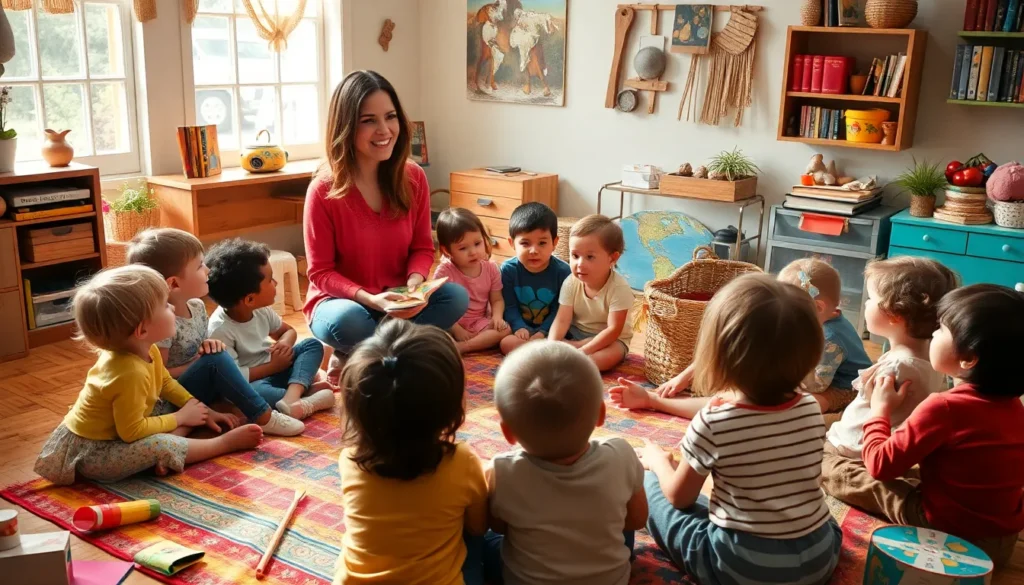Table of Contents
ToggleStorytime activities are a delightful way to ignite a child’s imagination and foster a love for reading. These engaging sessions not only entertain but also promote language development and critical thinking skills. Whether it’s through interactive storytelling, puppet shows, or creative crafts, storytime can transform ordinary moments into extraordinary adventures.
In today’s fast-paced world, finding ways to connect with children through storytelling is more important than ever. Parents and educators alike are discovering the magic of storytime activities as a tool for bonding and learning. By incorporating fun elements and hands-on experiences, they create memorable lessons that resonate long after the story ends. Embracing these activities can turn reading into a cherished ritual that cultivates a lifelong passion for books.
Overview of Storytime Activities
Storytime activities encompass a variety of engaging methods designed to enhance children’s reading experiences. By incorporating diverse elements, these activities foster imagination and creativity while promoting language skills.
Benefits of Storytime Activities
- Language Development: Storytime helps children expand vocabulary and understand sentence structure through exposure to different narratives.
- Critical Thinking: Engaging discussions about stories encourage children to analyze plots, characters, and moral lessons.
- Imagination: Stories stimulate creative thinking, allowing children to visualize scenes and characters.
Types of Storytime Activities
- Read-Aloud Sessions: Adults read books aloud, promoting listening skills and language acquisition.
- Interactive Storytelling: Involves audience participation, where children can respond, act out characters, or manipulate storytelling elements.
- Craft Activities: Art projects related to story themes strengthen comprehension and foster creativity.
Interactive Elements
- Props: Incorporating puppets, costumes, or tactile items enhances engagement and visualization.
- Sound Effects: Using music or sound effects aligns with story events, making sessions more immersive and enjoyable.
- Discussion Questions: Asking targeted questions during or after a story helps children think critically and express their ideas.
Incorporating Technology
- Digital Storybooks: Using e-books or apps offers interactive features like animations and read-aloud functions.
- Video Storytelling: Short films or animated stories provide an additional medium for storytelling, appealing to visual learners.
- Online Storytime Platforms: Virtual storytime events can connect children with authors or readers from around the world, broadening their exposure.
Storytime activities play a vital role in educational settings and at home. With a wide range of techniques available, parents and educators can tailor sessions to meet each child’s needs, creating enriching experiences that promote a lifelong passion for reading.
Benefits of Engaging in Storytime Activities

Engaging in storytime activities provides a multitude of benefits, fostering not only cognitive skills but also social interaction among children.
Cognitive Development
Storytime activities significantly enhance cognitive development. Exposure to different narratives improves vocabulary, comprehension, and listening skills. Interacting with various types of stories encourages critical thinking by allowing children to predict outcomes and analyze character motivations. Engaging in discussions about story elements fosters analytical skills, while hands-on activities, such as crafts related to stories, promote the application of knowledge gained during storytelling. Additionally, these activities stimulate imagination, as children visualize scenes and characters, enhancing creative thinking.
Social Interaction
Storytime activities promote essential social interaction among peers and caregivers. Participating in group sessions encourages cooperation as children share their thoughts and insights about the story. These discussions provide opportunities for children to develop conversational skills and learn to express opinions respectfully. The communal aspect of storytime fosters a sense of belonging and teamwork, which can be pivotal in building friendships. Using props or acting out scenes enhances collaboration and makes interactions more dynamic, engaging children in meaningful social play.
Types of Storytime Activities
Storytime activities come in various forms, each designed to enhance children’s engagement with stories. These activities foster language skills, creativity, and social interactions among participants.
Interactive Reading
Interactive reading promotes active participation during storytime. Children can engage with the story by asking questions and predicting what happens next. This method enhances comprehension and vocabulary. Use props, puppets, or sound effects to create a dynamic storytelling atmosphere. Frequent pauses allow children to share their thoughts or feelings about the characters, reinforcing their understanding and connection to the story.
Story-Based Crafts
Story-based crafts integrate creativity with narrative elements. Crafts can include making character masks, drawing scenes, or creating storyboards. These activities encourage children to express their interpretations of the story visually. Providing materials such as paper, scissors, markers, and glue helps children develop fine motor skills while deepening their engagement with the text. Crafting also fosters discussions about the story, enhancing comprehension and retention.
Role-Playing
Role-playing activities immerse children in the story by allowing them to act out scenes or characters. This experiential learning encourages empathy and understanding of different perspectives. Assign specific roles or let children choose, promoting collaboration and teamwork. Role-playing enhances language skills as children articulate dialogue and express emotions, deepening their connection to the narrative while fostering social interactions.
Tips for Effective Storytime Activities
Effective storytime activities require thoughtful planning and execution to maximize engagement and learning. By focusing on the right selections and environment, storytelling can become a powerful tool for development.
Choosing the Right Books
Choosing appropriate books is crucial for a successful storytime. Select books that match the children’s age and interests to ensure engagement. Look for vibrant illustrations, rhythmic text, and relatable themes. These elements capture attention and spark curiosity. Consider including a mix of genres to expose children to various storytelling styles. Incorporate nonfiction titles alongside fiction to cater to diverse interests, promoting learning alongside enjoyment. Rotate books regularly to maintain enthusiasm and introduce fresh perspectives.
Creating an Engaging Environment
Creating an engaging environment enhances the storytime experience. Arrange seating in a cozy, inviting way to encourage comfort and participation. Utilize soft lighting and minimize distractions to focus attention on the story. Incorporate props or visual aids that relate to the narrative, making the experience more interactive. Provide materials for hands-on activities, such as drawing tools or craft supplies, to connect the story to creative expression. Establish a routine that signals the start of storytime, helping children anticipate and prepare for this treasured activity.
Storytime activities offer a unique blend of education and enjoyment that nurtures a child’s love for reading. By making these sessions interactive and engaging, parents and educators can significantly enhance a child’s language skills and critical thinking. The variety of activities available ensures there’s something for every child, fostering creativity and imagination.
Establishing a routine around storytime not only builds anticipation but also strengthens the bond between caregivers and children. With thoughtful planning and the right resources, storytime can transform into a cherished experience that lays the foundation for lifelong learning and a passion for stories. Embracing these activities is a step towards enriching children’s lives in a meaningful way.




